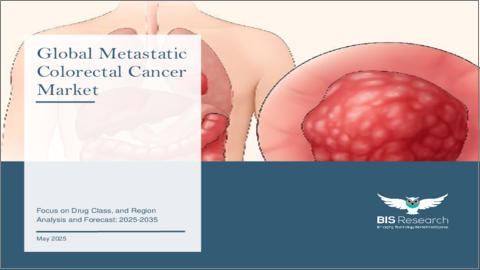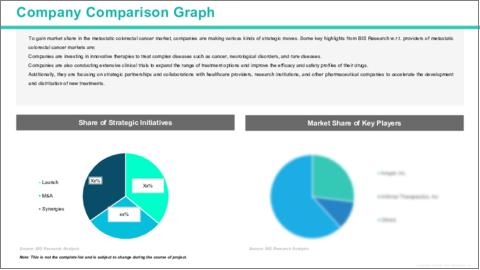|
|
市場調査レポート
商品コード
1734250
転移性大腸がんの世界市場:薬剤クラス別、地域別 - 分析と予測(2025年~2035年)Global Metastatic Colorectal Cancer Market: Focus on Drug Class, and Region - Analysis and Forecast, 2025-2035 |
||||||
カスタマイズ可能
|
|||||||
| 転移性大腸がんの世界市場:薬剤クラス別、地域別 - 分析と予測(2025年~2035年) |
|
出版日: 2025年05月28日
発行: BIS Research
ページ情報: 英文 100 Pages
納期: 1~5営業日
|
全表示
- 概要
- 図表
- 目次
世界の転移性大腸がん(mCRC)市場は、大腸がんの罹患率の上昇、治療技術の進歩、患者の転帰改善への関心の高まりに牽引され、がん領域の医薬品業界において重要なセグメントとなっています。
転移性大腸がんとは、結腸や直腸に発生したがんが、肝臓や肺などの遠隔臓器に転移した大腸がんのことです。mCRCは複雑で侵攻性のがんであり、一般的に予後不良で治療の選択肢が限られています。その結果、mCRC市場は、疾患を管理するだけでなく、生存期間を延長し、患者のQOLを向上させる効果的な治療法に対する高い需要が特徴となっています。
標的治療の導入は、転移性大腸がん市場における最も重要な進歩の一つです。ベバシズマブ(アバスチン)やセツキシマブ(アービタックス)などの治療薬は、がん細胞の増殖や転移に関与する分子経路を特異的に標的とするように開発され、従来の化学療法に比べて副作用が少なく、より効果的な治療選択肢を提供しています。これらの治療法は、特に病変が広範囲に広がっている症例では、効果を高めるために化学療法と併用されることが多いです。さらに、上皮成長因子受容体(EGFR)阻害剤や血管内皮成長因子(VEGF)阻害剤のような、特定の変異を標的とする新しいモノクローナル抗体や低分子阻害剤によって、治療の選択肢はさらに進歩しました。
mCRCの治療において最も画期的な開発の一つは免疫療法の登場です。免疫療法は、がん細胞を認識し攻撃するために身体の免疫系を利用する治療法です。ペムブロリズマブ(キイトルーダ)やニボルマブ(オプジーボ)などの免疫チェックポイント阻害剤は、特定のmCRC患者、特にマイクロサテライト不安定性高値(MSI-H)またはミスマッチ修復欠損(dMMR)腫瘍の患者において顕著な有効性を示しています。mCRC患者のサブセットを代表するこれらの患者は、免疫チェックポイント阻害剤ががんに対する身体の免疫反応を再活性化する能力により、全生存期間と無増悪生存期間の有意な改善を経験することができます。
これらの治療に加え、転移性大腸がん市場では、治療効果を最大化するために異なるクラスの複数の薬剤を併用する併用療法への注目が高まっています。例えば、化学療法に標的療法や免疫療法を併用することで、臨床試験で有望な結果が得られており、進行した患者の生存期間の延長やQOLの改善に繋がっています。
個別化医療の台頭も、転移性大腸がん市場における重要なトレンドのひとつです。ゲノム配列決定とバイオマーカー同定の進歩により、腫瘍医は患者の腫瘍の特徴に合わせた治療を行えるようになり、より正確で効果的な治療が保証されるようになっています。また、個別化医療は分子診断の使用を促進し、特定の治療が最も有効であると思われる患者を選択するのに役立つため、治療成果を最適化し、不必要な副作用を最小限に抑えることができます。
世界の転移性大腸がん市場は、複数の製薬企業やバイオテクノロジー企業が新規治療法の開発に積極的に取り組んでおり、技術革新のレベルが高いという特徴があります。これらの企業は大規模な研究開発パイプラインを有しており、その多くがmCRC治療を改善するための新たな分子標的や革新的な薬剤製剤の発見を目的とした臨床試験に取り組んでいます。
さらに、免疫療法や新規ドラッグデリバリーシステムに注力する新興バイオテクノロジー企業の転移性大腸がん市場への参入も増加しています。これらの企業はしばしば新しい科学的開発の最前線に立ち、転移性大腸がんの特定の分子サブタイプに対する標的療法を開発することで、転移性大腸がんの治療におけるアンメットニーズに応えようとしており、将来的により効果的な治療への希望をもたらしています。
影響
- 転移性大腸がんに対する需要の増加は、2025年~2035年の予測期間中、世界の転移性大腸がん市場の成長を下支えすると予測されています。
- 標的治療や個別化医療を含む医薬品開発の継続的な進展は、転移性大腸がん治療のための新規治療導入に大きな機会を提供するなどの機会により、市場は大きな成長率で成長すると予測されます。
地域別では、転移性大腸がん市場は全地域で大幅な成長を遂げています。北米は、有病率の高さ、ヘルスケアのインフラ整備、主要企業の存在などを背景に、転移性大腸がん治療の最大市場であり続けています。米国は、高度なヘルスケアと最先端のがん治療へのアクセスを有する重要な市場であり、欧州もまた、同地域の高水準のヘルスケアとがん研究への投資の増加により、重要な市場となっています。アジア太平洋地域は、特に中国やインドのような国々において、診断症例数の増加、認知度の向上、医療アクセスの改善により、今後数年間で最も高い成長が見込まれています。
当レポートでは、世界の転移性大腸がん市場について調査し、市場の概要とともに、薬剤クラス別、地域別の動向、および市場に参入する企業のプロファイルなどを提供しています。
目次
エグゼクティブサマリー
第1章 世界の転移性大腸がん市場:業界見通し
- 市場概要
- 転移性大腸がんの疫学的分析
- 地域別
- 転移性大腸がん市場における規制状況
- 米国における法的要件と枠組み
- EUにおける法的要件と枠組み
- 主な動向
- 臨床試験分析
- 市場力学
- 影響分析
- 市場促進要因
- 市場抑制要因
- 市場機会
第2章 世界の転移性大腸がん市場(薬剤クラス別、100万米ドル、2023年~2035年)
- 概要
- 抗EGFR(上皮成長因子受容体)阻害剤
- 抗VEGF(血管内皮細胞増殖因子)療法
- 抗HER2(ヒト上皮成長因子受容体2)療法
- 免疫チェックポイント阻害剤
- その他
第3章 世界の転移性大腸がん市場(地域別、100万米ドル、2023年~2035年)
- 北米
- 欧州
- アジア太平洋
第4章 世界の転移性大腸がん市場:競合情勢と企業プロファイル
- 競合情勢
- 主な発展と戦略
- 企業プロファイル
- Amgen Inc.
- Pfizer Inc.
- Eli Lilly and Company
- Sanofi
- Merck KGaA
- Novartis AG
- Takeda Pharmaceutical Company Limited
- Taiho Oncology
- Bristol-Myers Squibb Company
- Johnson & Johnson Services, Inc.
- Shanghai Henlius Biotech
- Inspirna
- Treos Bio
第5章 調査手法
List of Figures
- Figure: Global Metastatic Colorectal Cancer Market, Market Overview
- Figure: Global Metastatic Colorectal Cancer Market, Epidemiological Analysis
- Figure: Global Metastatic Colorectal Cancer Market Coverage
- Figure: Global Metastatic Colorectal Cancer Market Key Trends, Impact Analysis, 2023-2035
- Figure: Global Metastatic Colorectal Cancer Market, Competitive Landscape, January 2022-April 2025
List of Tables
- Table: Global Metastatic Colorectal Cancer Market, Regulatory Scenario
- Table: Global Metastatic Colorectal Cancer Market Dynamics, Impact Analysis
Global Metastatic Colorectal Cancer Market, Analysis and Forecast: 2025-2035
The global metastatic colorectal cancer (mCRC) market represents a critical segment within the oncology pharmaceutical industry, driven by the increasing incidence of colorectal cancer, advancements in therapeutic technologies, and a growing emphasis on improving patient outcomes. Metastatic colorectal cancer refers to a stage of colorectal cancer where the disease has spread from the original site in the colon or rectum to other parts of the body, often the liver, lungs, or other distant organs. It is a complex and aggressive form of cancer, typically associated with poor prognosis and limited treatment options. As a result, the mCRC market is characterized by high demand for effective therapies that can not only manage the disease but also extend survival and improve the quality of life for patients.
The introduction of targeted therapies has been one of the most significant advancements in the metastatic colorectal cancer market. Drugs such as bevacizumab (Avastin) and cetuximab (Erbitux) have been developed to specifically target the molecular pathways involved in cancer cell growth and metastasis, offering more effective treatment options with fewer side effects compared to traditional chemotherapy. These therapies are often used in combination with chemotherapy to improve efficacy, particularly in cases where the disease has spread extensively. Additionally, newer monoclonal antibodies and small molecule inhibitors targeting specific mutations, such as epidermal growth factor receptor (EGFR) inhibitors and vascular endothelial growth factor (VEGF) inhibitors, have further advanced treatment options.
One of the most transformative developments in the treatment of mCRC has been the advent of immunotherapy. Immunotherapy represents a class of treatments that harness the body's immune system to recognize and attack cancer cells. Immune checkpoint inhibitors, such as pembrolizumab (Keytruda) and nivolumab (Opdivo), have demonstrated impressive efficacy in certain mCRC patients, particularly those with microsatellite instability-high (MSI-H) or mismatch repair-deficient (dMMR) tumors. These patients, who represent a subset of the mCRC population, can experience significant improvements in overall survival and progression-free survival due to the ability of immune checkpoint inhibitors to reactivate the body's immune response against the cancer.
In addition to these treatment, the metastatic colorectal cancer market is witnessing a growing focus on combination therapies, where multiple drugs from different classes are used in tandem to maximize treatment efficacy. For instance, combining chemotherapy with targeted therapies or immunotherapies has shown promising results in clinical trials, leading to longer survival times and improved quality of life for patients with advanced disease.
The emergence of personalized medicine is another pivotal trend within the metastatic colorectal cancer market. With advancements in genomic sequencing and biomarker identification, oncologists can now tailor treatments to the individual characteristics of a patient's tumor, ensuring more precise and effective therapies. Personalized medicine also facilitates the use of molecular diagnostics, which help in selecting patients who are most likely to benefit from specific therapies, thus optimizing treatment outcomes and minimizing unnecessary side effects.
The global metastatic colorectal cancer market is characterized by a high level of innovation, with several pharmaceutical companies and biotechnology firms actively involved in the development of novel therapies. The companies have large R&D pipelines, and many of them are engaged in clinical trials aimed at discovering new molecular targets and innovative drug formulations to improve mCRC treatment.
Additionally, emerging biotech companies focusing on immunotherapy and novel drug delivery systems are increasingly entering the metastatic colorectal cancer market. These companies are often at the forefront of new scientific developments, seeking to address the unmet needs in the treatment of metastatic colorectal cancer by developing targeted therapies for specific molecular subtypes of the disease, offering hope for more effective treatments in the future.
Impact
- Increasing demand for metastatic colorectal cancer is anticipated to support the growth of the global metastatic colorectal cancer market during the forecast period 2025-2035.
- The market is expected to grow at a significant growth rate due to opportunities such as the Continued advancements in drug development, including targeted therapies and personalized medicine, offer significant opportunities for the introduction of novel therapies for metastatic colorectal cancer treatment.
Market Segmentation:
Segmentation 1: by Drug Class
- Anti-EGFR (Epidermal Growth Factor Receptor) Inhibitors
- Anti-VEGF (Vascular Endothelial Growth Factor) Therapies
- Anti-HER2 (Human Epidermal Growth Factor Receptor 2) Therapies
- Immune Checkpoint Inhibitors
- Others
Segmentation 2: by Region
- North America
- Europe
- Asia-Pacific
Geographically, the metastatic colorectal cancer market is witnessing substantial growth across all regions. North America remains the largest market for mCRC therapies, driven by the high prevalence of the disease, significant healthcare infrastructure, and the presence of leading pharmaceutical companies. The U.S. is a key market, with access to advanced healthcare and cutting-edge cancer treatments, while Europe also represents a significant market due to the high standards of healthcare in the region and increasing investments in oncology research. Asia-Pacific is expected to experience the highest growth in the coming years, driven by the increasing number of diagnosed cases, rising awareness, and improved healthcare access, particularly in countries like China and India.
Table of Contents
Executive Summary
Scope and Definition
Market/Product Definition
Key Questions Answered
Analysis and Forecast Note
1. Global Metastatic Colorectal Cancer Market: Industry Outlook
- 1.1 Market Overview
- 1.2 Epidemiological Analysis of Metastatic Colorectal Cancer
- 1.2.1 By Region
- 1.3 Regulatory Landscape of Global Metastatic Colorectal Cancer Market
- 1.3.1 Legal Requirement and Framework in the U.S.
- 1.3.2 Legal Requirement and Framework in the E.U.
- 1.4 Key Trends
- 1.5 Clinical Trial Analysis
- 1.6 Market Dynamics
- 1.6.1 Impact Analysis
- 1.6.2 Market Drivers
- 1.6.3 Market Restraint
- 1.6.4 Market Opportunities
2. Global Metastatic Colorectal Cancer Market, by Drug Class, $Million, 2023-2035
- 2.1 Overview
- 2.2 Anti-EGFR (Epidermal Growth Factor Receptor) Inhibitors
- 2.3 Anti-VEGF (Vascular Endothelial Growth Factor) Therapies
- 2.4 Anti-HER2 (Human Epidermal Growth Factor Receptor 2) Therapies
- 2.5 Immune Checkpoint Inhibitors
- 2.6 Others
3. Global Metastatic Colorectal Cancer Market, by Region, $Million, 2023-2035
- 3.1 North America
- 3.1.1 Key Market Participants in North America
- 3.1.2 Business Drivers
- 3.1.3 Business Challenges
- 3.1.4 Market Sizing and Forecast
- 3.1.4.1 North America Metastatic Colorectal Cancer Market, by Country
- 3.1.4.1.1 U.S.
- 3.1.4.1 North America Metastatic Colorectal Cancer Market, by Country
- 3.2 Europe
- 3.2.1 Key Market Participants in Europe
- 3.2.2 Business Drivers
- 3.2.3 Business Challenges
- 3.2.3.1 Europe Metastatic Colorectal Cancer Market, by Country
- 3.2.3.1.1 Germany
- 3.2.3.1.2 U.K.
- 3.2.3.1.3 France
- 3.2.3.1.4 Italy
- 3.2.3.1.5 Spain
- 3.2.3.1 Europe Metastatic Colorectal Cancer Market, by Country
- 3.3 Asia-Pacific
- 3.3.1 Key Market Participants in Asia-Pacific
- 3.3.2 Business Drivers
- 3.3.3 Business Challenges
- 3.3.3.1 Asia-Pacific Metastatic Colorectal Cancer Market, by Country
- 3.3.3.1.1 Japan
- 3.3.3.1 Asia-Pacific Metastatic Colorectal Cancer Market, by Country
4. Global Metastatic Colorectal Cancer Market: Competitive Landscape and Company Profiles
- 4.1 Competitive Landscape
- 4.1.1 Key Developments and Strategies
- 4.1.1.1 Funding Activities
- 4.1.1.2 Mergers and Acquisitions
- 4.1.1.3 Regulatory Approvals
- 4.1.1.4 Partnerships, Collaborations and Business Expansions
- 4.1.1 Key Developments and Strategies
- 4.2 Company Profiles
- 4.2.1 Amgen Inc.
- 4.2.1.1 Overview
- 4.2.1.2 Product Portfolio
- 4.2.1.3 Target Customers
- 4.2.1.4 Key Professionals
- 4.2.1.5 Analyst View
- 4.2.2 Pfizer Inc.
- 4.2.2.1 Overview
- 4.2.2.2 Product Portfolio
- 4.2.2.3 Target Customers
- 4.2.2.4 Key Professionals
- 4.2.2.5 Analyst View
- 4.2.3 Eli Lilly and Company
- 4.2.3.1 Overview
- 4.2.3.2 Product Portfolio
- 4.2.3.3 Target Customers
- 4.2.3.4 Key Professionals
- 4.2.3.5 Analyst View
- 4.2.4 Sanofi
- 4.2.4.1 Overview
- 4.2.4.2 Product Portfolio
- 4.2.4.3 Target Customers
- 4.2.4.4 Key Professionals
- 4.2.4.5 Analyst View
- 4.2.5 Merck KGaA
- 4.2.5.1 Overview
- 4.2.5.2 Product Portfolio
- 4.2.5.3 Target Customers
- 4.2.5.4 Key Professionals
- 4.2.5.5 Analyst View
- 4.2.6 Novartis AG
- 4.2.6.1 Overview
- 4.2.6.2 Product Portfolio
- 4.2.6.3 Target Customers
- 4.2.6.4 Key Professionals
- 4.2.6.5 Analyst View
- 4.2.7 Takeda Pharmaceutical Company Limited
- 4.2.7.1 Overview
- 4.2.7.2 Product Portfolio
- 4.2.7.3 Target Customers
- 4.2.7.4 Key Professionals
- 4.2.7.5 Analyst View
- 4.2.8 Taiho Oncology
- 4.2.8.1 Overview
- 4.2.8.2 Product Portfolio
- 4.2.8.3 Target Customers
- 4.2.8.4 Key Professionals
- 4.2.8.5 Analyst View
- 4.2.9 Bristol-Myers Squibb Company
- 4.2.9.1 Overview
- 4.2.9.2 Product Portfolio
- 4.2.9.3 Target Customers
- 4.2.9.4 Key Professionals
- 4.2.9.5 Analyst View
- 4.2.10 Johnson & Johnson Services, Inc.
- 4.2.10.1 Overview
- 4.2.10.2 Product Portfolio
- 4.2.10.3 Target Customers
- 4.2.10.4 Key Professionals
- 4.2.10.5 Analyst View
- 4.2.11 Shanghai Henlius Biotech
- 4.2.11.1 Overview
- 4.2.11.2 Product Portfolio
- 4.2.11.3 Target Customers
- 4.2.11.4 Key Professionals
- 4.2.11.5 Analyst View
- 4.2.12 Inspirna
- 4.2.12.1 Overview
- 4.2.12.2 Product Portfolio
- 4.2.12.3 Target Customers
- 4.2.12.4 Key Professionals
- 4.2.12.5 Analyst View
- 4.2.13 Treos Bio
- 4.2.13.1 Overview
- 4.2.13.2 Product Portfolio
- 4.2.13.3 Target Customers
- 4.2.13.4 Key Professionals
- 4.2.13.5 Analyst View
- 4.2.1 Amgen Inc.





